Orchha Fort Complex
Weather :
Tags : Forts & Palaces
Timings : 9:00 AM to 6:00 PM
Time Required : Over 2 hours
Entry Fee : INR 10 for Indians, INR 250 for foreigners
Orchha Fort Complex, Jhansi Overview
The small town of Orchha situated 16 km from Jhansi in Madhya Pradesh emanates an architecturally historicized complex called the Orchha Fort Complex. It was built in 1501 AD by Raja Rudra Pratap Singh of the Bundela dynasty. It is a manifestation of Rajput and Mughal architecture flamboyantly decorated with latticed windows, projected platforms and balconies and mirrors on ceilings. Built by the descendants of the Bundela Dynasty, the Orchha Fort complex houses several monuments such as the Raja Mahal, Sheesh Mahal, Rai Praveen Mahal and also gardens such as the Phool Bagh.
Read More on Orchha Fort Complex
Timings and Entry Fee
The entry fee for Jahangir Mahal is INR 10 for Indians and INR 30 for foreign citizens.
The Light and Sound Show attracts many tourists and takes place after the fort is closed. In summers, the allotted time for Light and Sound Show is from 7:45 PM to 8:30 PM in English and 8:45 PM to 9:45 PM in Hindi. In winters, the allotted time is from 6:30 PM to 7:30 PM in English and 7:45 PM to 8:45 PM in Hindi. The entry fee is INR 100 for adults and INR 50 for children.
The fort is open from 9:00 AM to 6:00 PM throughout the week.
In order to escape the escalating temperatures of summers which easily cross 40 degrees Celsius, the recommended time to visit the fort is from October to March.
History of Orchha Fort Complex
The Sheesh Maha initially built for Raja Udait Singh has now been converted into a hotel but has managed to ensemble the Mughal-Rajput style of architecture. The Phool Bagh is elegantly decorated with flowers and a line of fountains with an archaic cooling system to retreat to in summers.
There are guides available to escort you through its history, but no audio guides.
The recommended time to visit this fort is in winter and spring to escape the escalating temperatures of over 40 degree Celsius during summers.
Architecture of Orchha Fort Complex
The palatial residence has projecting platforms and balconies, latticed windows, murals and paintings with Gods and other mythological creatures, high ceilings with pavilions and ceilings with carved mirrors. The monuments that followed were built by the successive kings of the Bundela dynasty.
Raja Mahal
The King’s Palace, Raja Mahal or Raja Mandir was where the royal families resided till 1783. While the exterior adheres to simplicity, the interior is languid with paintings and murals with religious themes, mythological creatures, high ceilings and ceilings and walls with interspersed mirrors. The architectural design of the palace allowed a variation of temperature and mood with the amount of sunlight that entered. There are many in-built secret passages in the fort too.
A section of the fort was converted into a Rama Raja temple. There is a historical legend behind this conversion. It was built during Raja Madhukar Shah’s reign form 1554 to 1591. He was a devotee of Lord Krishna, while his queen, Rani Ganeshkuwari was a devotee of Lord Rama. According to a local folktale, Lord Rama asked Rani Ganeshkuwari to build a temple for Him in her dream, and thus began construction of the Chaturbhuj Temple. Rani Ganeshkuwari went to Ayodhya to get an idol of Rama for the temple. She placed it in her palace because the Chaturbhuj temple was still under construction. However, she was unaware of the injunction that an idol that would later be deified must not be placed within the four walls of a palace.
Once the temple was constructed, the idol of Raja Rama refused to be moved. Therefore, that section of the palace was converted to Rama Mandir while the Chaturbhuj Temple stayed idle.
This is the only temple in the country where Raja Rama, even though deified to being a God, is worshipped as a king.
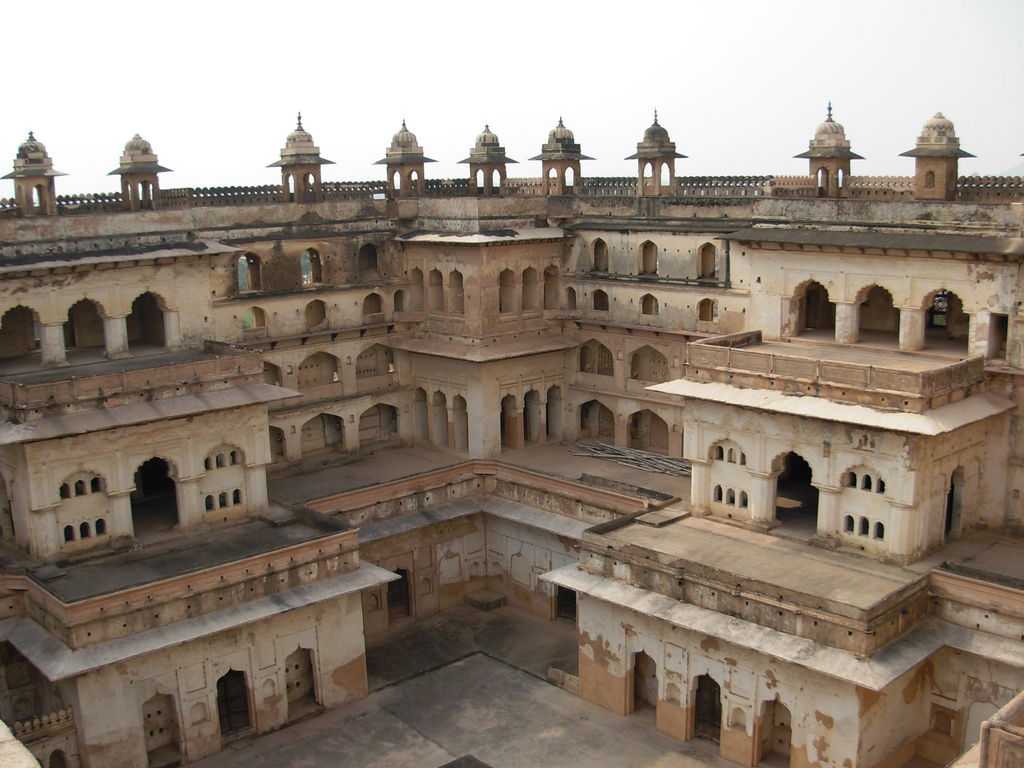
Jahangir Mahal
The four-levelled construction of Jahangir Mahal was completed in 1605 by Raja Bir Singh Deo. It was built as a gesture of gratitude towards the Mughal Emperor Jahangir upon his visit to Orchha for one night. The architecture is fused between Mogul and Rajput style. The symmetrically square shape is ornamented with eight domes, latticed windows, projected balconies and a steep stairway that provides a magnificent view of the Betwa River flowing by. The entrance is mounted with turquoise tiles and has an artistic gateway decorated in a traditional style. The palace has a small archaeological museum housing artefacts from the 16th century.
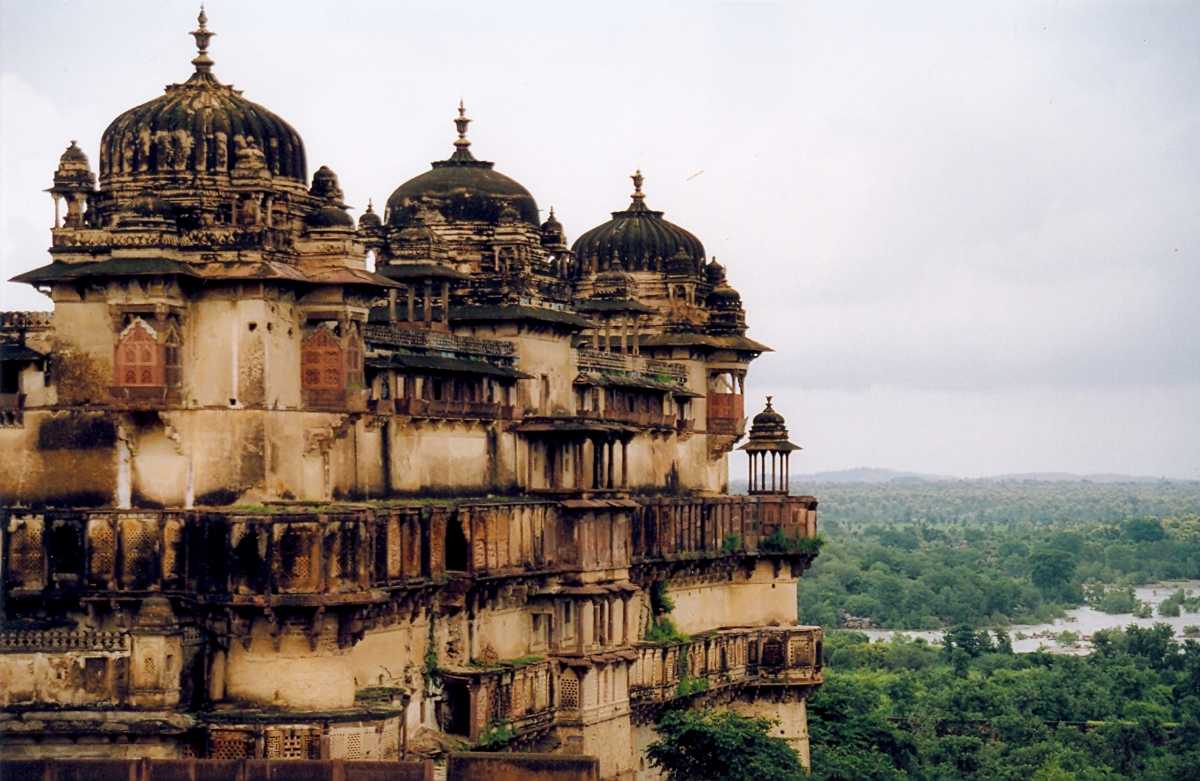
Rai Praveen Mahal
The Rai Praveen Mahal follows the Jahangir Mahal. It was built in 1618 by Raja Indrajeet for his escort, Rai Praveen. She was also a poet, musician and a remarkably beautiful woman. She was also referred to as the ‘Nightingale of Orchha’. There is a luscious portrait of her decorating the Mahal’s walls. Several other portraits of her in different dancing positions and those of Raja Indrajeet horse-riding are also a common attraction.
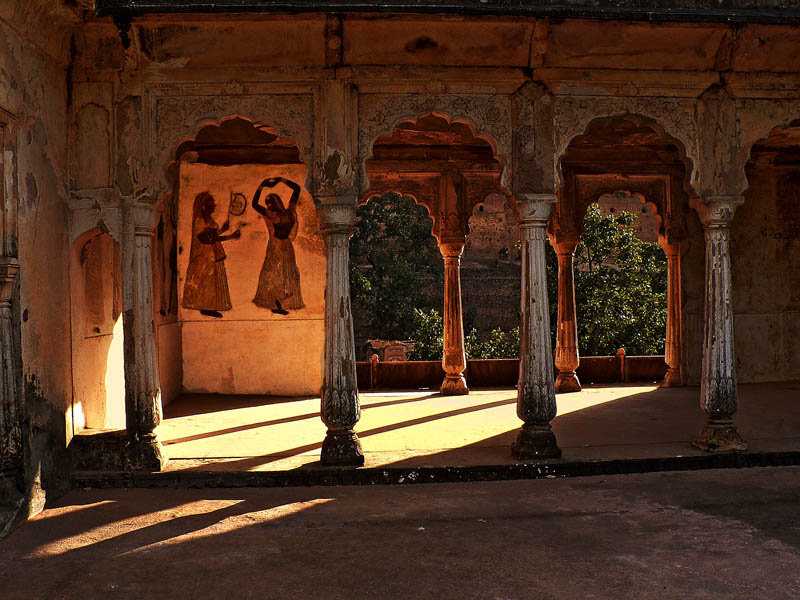
Sheesh Mahal
The Sheesh Mahal adorns the Jahangir Mahal on one side, and Raja Mahal on the other. It has now been converted into a hotel with eye-catching colour schemes, high ceiling dining hall and two royal suites that provide a splendid view of the city.
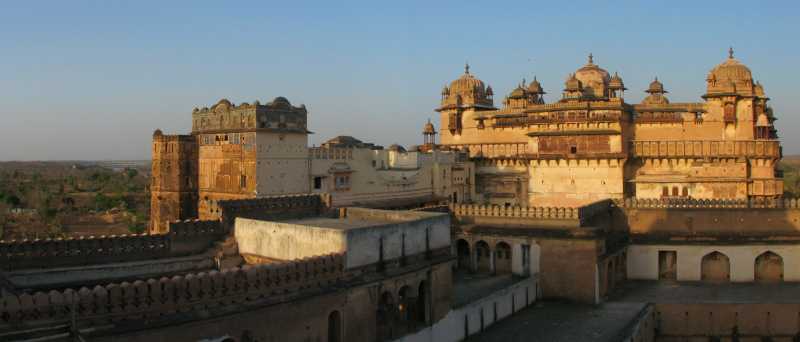
Phool Bagh
The Phool Bagh is a garden glistening with colourful flowers and a line of fountains mystifying its beauty. Under the Phool Bagh is situated the ‘royal summer retreat’ where a raised bowl-shaped structure called the Chandan Katora is a base for water from which water droplets trickle down, creating a rainy semblance.
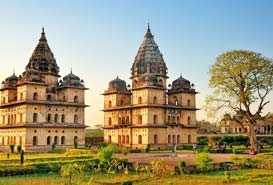
How To Reach Orchha Fort Complex
There are no trains available to Orchha either. The nearest Railway Station is the Barwasagar Station which is 8 km from Orchha, or the Jhansi Junction which is 14 km away. This distance can be covered using a taxi too. The nearest airport is Gwalior Airport in Gwalior at a distance of 108 km. The most convenient form of covering this distance is by hiring a cab.
Top Hotel Collections
Top Hotels Near Orchha Fort Complex
Orchha Fort Complex Reviews

Have a Question on Orchha Fort Complex?

experience.